what was germanys port of entry to the us
| Lübeck | |
|---|---|
| Urban center | |
| Clockwise from height: skyline with St Jacob'due south, St Mary'south, and St Peter's, Trave and Lübeck Cathedral in winter, Trave with St Mary's and St Peter's, rima oris of the Trave in Travemünde with Maritim high-ascension and Passat, Lübeck Cathedral and Sacred Middle Church, Holsten Gate | |
| Flag Coat of artillery | |
| Location of Lübeck | |
| Lübeck Show map of Germany Lübeck Evidence map of Schleswig-Holstein | |
| Coordinates: 53°52′xi″N 10°41′11″E / 53.86972°N 10.68639°Eastward / 53.86972; 10.68639 Coordinates: 53°52′eleven″N ten°41′11″E / 53.86972°Northward x.68639°East / 53.86972; 10.68639 | |
| Country | Frg |
| State | Schleswig-Holstein |
| District | Urban commune |
| Subdivisions | 35 Stadtbezirke |
| Regime | |
| • Mayor | Jan Lindenau (SPD) |
| • Governing parties | SPD / CDU |
| Surface area | |
| • Total | 214.13 km2 (82.68 sq mi) |
| Elevation | thirteen m (43 ft) |
| Population (2020-12-31)[i] | |
| • Full | 215,846 |
| • Density | 1,000/km2 (2,600/sq mi) |
| Fourth dimension zone | UTC+01:00 (CET) |
| • Summertime (DST) | UTC+02:00 (CEST) |
| Postal codes | 23501−23570 |
| Dialling codes | 0451, 04502 |
| Vehicle registration | HL[ii] |
| Website | www.luebeck.de |
| UNESCO Globe Heritage Site | |
|---|---|
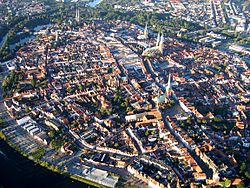 Aerial view of the sometime town | |
| Criteria | Cultural: iv |
| Reference | 272 |
| Inscription | 1987 (11th Session) |
| Area | 81.i ha |
| Buffer zone | 693.8 ha |
Lübeck (German: [ˈlyːbɛk] ( ![]() listen ); Depression High german also Lübeek ), officially the Hanseatic Urban center of Lübeck (German: Hansestadt Lübeck), is a city in Northern Germany. With around 217,000 inhabitants, Lübeck is the second-largest metropolis on the German Baltic coast and in the state of Schleswig-Holstein, after its capital of Kiel, and is the 35th-largest metropolis in Germany. The urban center lies in Holstein, northeast of Hamburg, on the rima oris of the River Trave, which flows into the Bay of Lübeck in the borough of Travemünde, and on the Trave's tributary Wakenitz. The city is office of the Hamburg Metropolitan Region, and is the southwesternmost city on the Baltic, as well as the closest bespeak of access to the Baltic from Hamburg. The port of Lübeck is the second-largest German Baltic port after the port of Rostock. The city lies in the Northern Low Saxon dialect area of Low German language.
listen ); Depression High german also Lübeek ), officially the Hanseatic Urban center of Lübeck (German: Hansestadt Lübeck), is a city in Northern Germany. With around 217,000 inhabitants, Lübeck is the second-largest metropolis on the German Baltic coast and in the state of Schleswig-Holstein, after its capital of Kiel, and is the 35th-largest metropolis in Germany. The urban center lies in Holstein, northeast of Hamburg, on the rima oris of the River Trave, which flows into the Bay of Lübeck in the borough of Travemünde, and on the Trave's tributary Wakenitz. The city is office of the Hamburg Metropolitan Region, and is the southwesternmost city on the Baltic, as well as the closest bespeak of access to the Baltic from Hamburg. The port of Lübeck is the second-largest German Baltic port after the port of Rostock. The city lies in the Northern Low Saxon dialect area of Low German language.
Lübeck is famous for having been the cradle and the de facto capital of the Hanseatic League. Its city centre is Federal republic of germany's about extensive UNESCO World Heritage Site. While the urban center'due south symbol is the Holsten Gate, Lübeck's skyline is dominated by the seven towers of its five main churches St Mary's, Lübeck Cathedral, St Jacob'southward (Jakobikirche (Lübeck)), St Peter's (Petrikirche (Lübeck)), and St Giles'. The cathedral, finished around 1230, was the first large brickwork church in the Baltic region. St Mary'due south, finished in 1351, served as model for the other Brick Gothic churches around the Baltic. It has the 2d-tallest ii-steeples façade afterwards Cologne Cathedral, which only surpassed information technology in 1880, the tallest brick vault, and is the second-tallest brickwork structure after St Martin's in Landshut. Travemünde is a famous seaside resort, and its Maritim high-rise serves as the second-tallest lighthouse in the world at 114 metres (374 ft) high. Lübeck is also known for Lübeck Marzipan.
History [edit]

Humans settled in the area effectually what today is Lübeck later on the final Ice Historic period ended virtually 9700 BCE. Several Neolithic dolmens can be found in the surface area.
Effectually 700 AD, Slavic peoples started moving into the eastern parts of Holstein, an area previously settled by Germanic inhabitants who had moved on in the Migration Period. Charlemagne, whose efforts to Christianise the surface area were opposed by the Germanic Saxons, expelled many of the Saxons and brought in Polabian Slavs allies. Liubice (the place-proper noun means "lovely") was founded on the banks of the River Trave about 4 km (ii.5 mi) north of the present-day urban center-center of Lübeck. In the 10th century, it became the most important settlement of the Obotrite confederacy and a castle was built. In 1128, the heathen Rani from Rügen razed Liubice.

In 1143, Adolf Two, Count of Schauenburg and Holstein, founded the modern town equally a German settlement on the river island of Bucu. He congenital a new castle, first mentioned past the chronicler Helmold every bit existing in 1147. Adolf had to sacrifice the castle to the Duke of Saxony, Henry the King of beasts, in 1158. After Henry'south autumn from ability in 1181, the town became an Imperial city for eight years.[ citation needed ] Emperor Barbarossa (reigned 1152–1190) ordained that the city should have a ruling council of 20 members. With the council dominated by merchants, pragmatic trade interests shaped Lübeck's politics for centuries. The council survived into the 19th century. The town and castle changed buying for a menstruum afterwards and formed office of the Duchy of Saxony until 1192, of the Canton of Holstein until 1217, and of the kingdom of Denmark until the Battle of Bornhöved in 1227.
Hanseatic city [edit]
Effectually 1200, the port became the primary bespeak of departure for colonists leaving for the Baltic territories conquered by the Livonian Order, and later on, by the Teutonic Order. In 1226, Emperor Frederick 2 elevated the town to the status of an Royal free metropolis, past which it became the Free Metropolis of Lübeck.
| Appurtenances | Primary origin | Imports | Exports | Total |
|---|---|---|---|---|
| Cloth | Flanders | 120.8 | 39.seven | 160.5 |
| Fish | Scania | 64.7 | half-dozen.one | seventy.viii |
| Table salt | Luneburg | - | 61.6 | 61.vi |
| Butter | Sweden | 19.2 | 6.8 | 26 |
| Skins, furs | Russia, Sweden | xiii.iii | 3.seven | 17 |
| Grain | Prussia | 13 | 0.8 | 13.8 |
| Wax | Russia, Prussia | 7.2 | v.eight | 13 |
| Beer | Wendish towns | four.1 | 1.9 | 6 |
| Copper | Sweden, Hungary | 2.ii | ii.4 | 4.half-dozen |
| Fe | Sweden, Hungary | 2.4 | 2.2 | 4.half dozen |
| Oil | Flanders | ii.seven | 1.5 | 4.2 |
| Flax | Livonia, North Germany | 0.iv | 3 | 3.iv |
| Foodstuffs | passim | 2.2 | 1.2 | iii.4 |
| Argent | Sweden | 0.seven | 2 | ii.7 |
| Wine | Rhineland | ane.3 | 0.9 | two.2 |
| Various | 39.9 | 16.half-dozen | 56.5 | |
| Unclassified | 41 | 49 | 90 | |
| Total (rounded) | 338.9 | 206.9 | 545.eight[three] |
In the 14th century, Lübeck became the "Queen of the Hanseatic League", beingness by far the largest and most powerful member of that medieval trade system. In 1375, Emperor Charles IV named Lübeck one of the five "Glories of the Empire", a title shared with Venice, Rome, Pisa, and Florence.
| Arrivals | % | Origin, destination | Departures | % |
|---|---|---|---|---|
| 289 | 33.seven | Mecklenburg-Pomerania | 386 | 42.3 |
| 250 | 28.eight | Skania | 207 | 22.8 |
| 145 | 16.8 | Prussia | 183 | xx.ane |
| 96 | 11.2 | Sweden | 64 | 7 |
| 35 | iv.3 | Livonia | 43 | 4.7 |
| 28 | three.2 | Fehmarn | 27 | 3 |
| 12 | 1.half dozen | Bergen | - | - |
| 3 | 0.iv | Flemish region | 1 | 0.i |
| 858 | 100 | 911 | 100[iv] |
Several conflicts about trading privileges resulted in fighting between Lübeck (with the Hanseatic League) and Kingdom of denmark and Norway – with varying outcome. While Lübeck and the Hanseatic League prevailed in conflicts in 1435 and 1512, Lübeck lost when it became involved in the Count'southward Feud, a civil war that raged in Denmark from 1534 to 1536. Lübeck also joined the pro-Lutheran Schmalkaldic League of the mid-16th century.
| Butter | Copper | |||||||
|---|---|---|---|---|---|---|---|---|
| Year | Lübeck | % | Danzig | % | Lübeck | % | Danzig | % |
| 1368 | 2000 | 460 | ||||||
| 1369 | 900 | 530 | ||||||
| 1400 | 247 | 45 | ||||||
| 1492 | 76 | 1250 | ||||||
| 1493 | - | 2849 | ||||||
| 1494 | - | 1906 | ||||||
| 1495 | - | 435 | ||||||
| 1559 | 1254 | 89 | 150 | 11 | - | |||
| 1572 | 1350 | 74 | 252 | fourteen | 564 | 94 | 3 | 0.v |
| 1582 | 1224 | 86 | 105 | 10 | 803 | 85 | 59 | six.2 |
| 1583 | 1133 | 77 | 165 | 11 | 2153 | 70 | 122 | 4 |
| 1584 | 909 | 74 | 177 | fourteen | 2415 | 69 | 49 | one.4 |
| 1591 | 742 | 74 | 170 | 17 | 1487 | 74 | 247 | 12 |
| 1600 | - | - | 56 | 5 | - | - | 1 | 0 |
| 1610 | 64 | 47 | seven | 5 | 1411 | 83 | 18 | one.1 |
| 1620 | 659 | 76 | l | 6 | 7434 | 86 | 12 | 0.1[6] |
After its defeat in the Count's Feud, Lübeck's ability slowly declined. The city remained neutral in the Thirty Years' War of 1618–1648, just the combination of the devastation from the decades-long war and the new transatlantic orientation of European trade caused the Hanseatic League – and thus Lübeck with information technology – to decline in importance. However, even later on the de facto disbanding of the Hanseatic League in 1669, Lübeck still remained an important trading boondocks on the Baltic Sea.

Former traditions, new challenges [edit]
Franz Tunder was the organist in the Marienkirche. It was part of the tradition in this Lutheran congregation that the organist would pass on the duty in a dynastic marriage.[ clarification needed ] In 1668, his girl Anna Margarethe married the groovy Danish-German composer Dieterich Buxtehude, who was the organist at the Marienkirche in Lübeck until at least 1703. Some of the greatest composers of the 24-hour interval came to the church to hear his renowned playing.
In the course of the war of the Fourth Coalition confronting Napoleon, troops under Marshal Jean Baptiste Bernadotte (who would afterward become King of Sweden) occupied Lübeck after a battle confronting Prussian General Gebhard Blücher on 6 November 1806 due to the latter's illegal use of the city as a fortress, in violation of Lübeck'due south neutrality, following the French pursuit of his corps after the Battle of Jena-Auerstadt. Under the Continental System, the Land banking company went into bankruptcy. In 1811, the French Empire formally annexed Lübeck equally part of French republic; the anti-Napoleonic allies liberated the area in 1813, and the Congress of Vienna of 1815 recognised Lübeck every bit an independent costless metropolis. The urban center became a member of the German language Confederation (1815–1866) the N German Confederation (1866–1871) the German Reich (1871–1918) and the Weimar Republic (1919–1933).

Entry of the Fusilier battalion on June 18, 1871 in Lübeck.
During the Franco-Prussian War, the battalion de Fusilier of Lübeck was part of the "2d Hanseatic Infantry Regiment No. 76". On the day of the Battle of Loigny the commander of the 17th Segmentation, Hugo von Kottwitz, of the morning time advanced in forepart of the Fusilier battalion of the regiment, urging them to "commemorate the bravery of the Hanseatic League". his attack in the north while the other battalions turned towards Loigny. This shock surprised the French so much that they were invaded by their flank. They fled to the Fougeu place and were kicked out of this. The boxing was to become the founding myth of the concluding Lübeck regiment, 3rd Hanseatic Infantry Regiment No. 162, which was founded in 1897. When the battalion commander returned to Lübeck with his battalion, he was appointed regimental commander.
Under the Tertiary Reich (1933–1945) the Nazis passed the Greater Hamburg Act, which incorporated the metropolis of Lübeck into the Schleswig-Holstein province of Prussia, effective April 1, 1937. It thereby lost its status as an independent constituent land.
Writer Thomas Mann was a fellow member of the Isle of man family of Lübeck merchants. His well-known 1901 novel Buddenbrooks made readers in Germany (and later worldwide, through numerous translations) familiar with the manner of life and mores of the 19th-century Lübeck bourgeoisie.

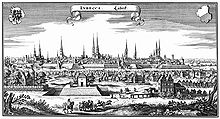
During World War II (1939–1945), Lübeck became the starting time High german city to suffer substantial Royal Air Force (RAF) bombing. The attack of 28 March 1942 created a firestorm that caused severe damage to the historic centre. This raid destroyed three of the main churches and large parts of the built-upwards surface area; the bells of St Marienkircke plunged to the stone floor.[7] Germany operated a prisoner-of-war army camp for officers, Oflag Ten-C, virtually the urban center from 1940 until Apr 1945. The British Second Regular army entered Lübeck on 2 May 1945 and occupied it without resistance.
On 3 May 1945, one of the biggest disasters in naval history occurred in the Bay of Lübeck when RAF bombers sank three ships: the SS Cap Arcona, the SS Germany, and the SS Thielbek – which, unknown to them, were packed with concentration-camp inmates. Almost 7,000 people died.
Lübeck'due south population grew considerably, from about 150,000 in 1939 to more than than 220,000 subsequently the war, attributable to an influx of indigenous German language refugees expelled from the former eastern provinces of Germany in the Communist Bloc. Lübeck remained part of Schleswig-Holstein after World War II (and consequently lay within Due west Germany). It stood direct on what became the inner German border during the division of Deutschland into two states in the Cold War period. South of the metropolis, the border followed the path of the river Wakenitz, which separated the Germanys by less than 10 m (33 ft) in many parts. The northernmost border crossing was in Lübeck's district of Schlutup. Lübeck spent decades restoring its historic metropolis center. In 1987, UNESCO designated this surface area a Globe Heritage Site.
Lübeck became the scene of a notable art scandal in the 1950s. Lothar Malskat was hired to restore the medieval frescoes of the cathedral of the Marienkirche, which were discovered after the cathedral had been badly damaged during World War II. Instead, he painted new works, which he passed off as restorations, fooling many experts. Malskat later revealed the deception himself. Günter Grass featured this incident in his 1986 novel The Rat.

On the night of 18 Jan 1996, a burn down broke out in a home for foreign refugees, killing 10 people and severely injuring more than thirty others, mostly children. Nigh of the shelter's inhabitants thought it was a racist set on, as they stated that they had encountered other overt hostility in the city.[8] The police and the local courtroom were criticized at the time for ruling out racism as a possible motive earlier even get-go preliminary investigations.[9] But by 2002, the courts found all the Germans involved[10] not guilty; the perpetrators have non been caught.
In April 2015, Lübeck hosted the G7 briefing.[11]
Demographics [edit]
In 2015, the city had a population of 218,523. The largest ethnic minority groups are Turks, Central Europeans (Poles), Southern Europeans (mostly Greeks and Italians), Eastern Europeans (east.g. Russians), Arabs, and several smaller groups.
Population development since 1227:
| Twelvemonth | Popular. | ±% |
|---|---|---|
| 1227 | vi,000 | — |
| 1400 | 17,200 | +186.vii% |
| 1600 | 22,570 | +31.2% |
| 1708 | 19,978 | −11.5% |
| 1871 | 39,743 | +98.9% |
| 1900 | 82,098 | +106.six% |
| 1910 | 98,656 | +20.2% |
| 1925 | 120,788 | +22.4% |
| 1939 | 154,811 | +28.2% |
| 1950 | 238,276 | +53.9% |
| 1956 | 228,670 | −4.0% |
| 1961 | 236,477 | +three.4% |
| 1970 | 239,657 | +ane.3% |
| 1975 | 232,270 | −three.1% |
| 1980 | 220,588 | −v.0% |
| 1990 | 214,758 | −ii.six% |
| 2000 | 213,399 | −0.half-dozen% |
| 2010 | 210,513 | −i.four% |
| 2015 | 216,253 | +ii.7% |
| 2019 | 217,346 | +0.v% |
| source:[12] [ circular reference ] | ||
Population structure:[13]
| Rank | Nationality | Population (31.12.2020) |
|---|---|---|
| ane | | four,077 |
| 2 | | two,733 |
| iii | | 2,496 |
| four | | 1,228 |
| 5 | | one,191 |
| 6 | | 998 |
| seven | | 983 |
| 8 | | 724 |
| 9 | | 709 |
Tourism [edit]

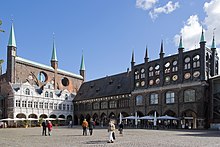



Hospital of the Holy Spirit, 1 of the oldest social institutions of Lübeck (1260)
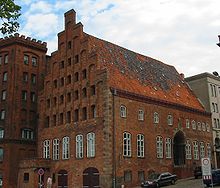
In 2019 Lübeck reached two million overnight stays. Lübeck is famous for its medieval Urban center Centre with the Churches, the Holstentor, its minor alleys and so much more. Lübeck has been called "Dice Stadt der vii Türme" (The City of vii Towers) due to its 7 prominent church building towers.
Buildings [edit]
Much of the old town has kept a medieval appearance with old buildings and narrow streets. At one time, the town could just exist entered by whatsoever of iv town gates, ii of which remain today, the well-known Holstentor (1478) and the Burgtor (1444).
The old town centre is dominated by seven church building steeples. The oldest are the Lübeck Cathedral and the Marienkirche (Saint Mary's), both dating from the 13th and 14th centuries.
Built in 1286, the Holy Spirit Infirmary at Koberg is i of the oldest existing social institutions in the world and one of the nearly important buildings in the city. The Holy Spirit Hospital is in parts an old-folk and nursing home. Historic parts tin exist visited.
Other sights include:
- The City Hall
- St. Catherine's Church, a church building that belonged to a one-time monastery, now the Katharineum, a Latin school
- Thomas Mann's house
- Günter Grass's house
- Church of St Peter
- Church of St Lawrence, located on the site of a cemetery for people who died during the 16th-century plague
- Church of St Jacob, 1334
- Church of the Sacred Heart
- Church of St Aegidien
- the Salzspeicher, historic warehouses where salt delivered from Lüneburg awaited shipment to Baltic ports
- The City of Travemünde on the Coast of the Baltic Body of water.
Similar many other places in Federal republic of germany, Lübeck has a long tradition of a Christmas market place in December, which includes the famous handicrafts market inside the Heiligen-Geist-Hospital (Hospital of the Holy Spirit), located at the northern end of Königstrasse.
Museums [edit]
Lübeck has many small museums, such as the St. Anne'south Museum Quarter, Lübeck, the Behnhaus, the European Hansemuseum, and the Holstentor. Lübeck Museum of Theatre Puppets is a privately run museum. Waterside attractions are a lightvessel that served Fehmarnbelt and the Lisa von Lübeck, a reconstruction of a Hanseatic 15th century caravel. The marzipan museum in the second floor of Café Niederegger in Breite Strasse explains the history of marzipan, and shows historical woods molds for the production of marzipan blocks and a group of historical figures made of marzipan.
Food and potable [edit]
Lübeck is famous for its marzipan industry. According to local legend, marzipan was first made in Lübeck, maybe in response either to a military siege of the metropolis or a famine year. The story, mayhap apocryphal, is that the city ran out of all food except stored almonds and sugar, which were used to make loaves of marzipan "bread".[14] Others believe that marzipan was actually invented in Persia a few hundred years before Lübeck claims to take invented it. The best known producer is Niederegger, which tourists often visit while in Lübeck, especially at Christmas time.[fifteen]
The Lübeck wine trade dates dorsum to Hanseatic times. Ane Lübeck specialty is Rotspon ( ![]() listen(assist·info) ), wine made from grapes processed and fermented in France and transported in wooden barrels to Lübeck, where it is stored, aged and bottled.[sixteen]
listen(assist·info) ), wine made from grapes processed and fermented in France and transported in wooden barrels to Lübeck, where it is stored, aged and bottled.[sixteen]
Like other coastal North German communities, Fischbrötchen and Brathering are popular takeaway foods, given the abundance of fish varieties.
Education [edit]
Lübeck has three universities, the University of Lübeck, the Technical Academy of Practical Sciences Lübeck, and the Lübeck Academy of Music. The Graduate School for Computing in Medicine and Life Sciences is a central faculty of the University and was founded past the German Excellence Initiative. The International School of New Media is an affiliated plant of the university.
Districts [edit]

The skyline of the old town as seen from North

Lübeck chief station (Lübeck Hbf)

Lübeck civil registration office, in the St. Jürgen zone

The metropolis of Lübeck is divided into 10 zones. These again are bundled into altogether 35 urban districts. The x zones with their official numbers, their associated urban districts and the numbers of inhabitants of the quarters:
- 01 Metropolis centre (~ 12,000 inhabitants)
The Innenstadt is the main tourist attraction and consists of the old town as well as the former ramparts. It is the oldest and smallest role of Lübeck.
- 02 St. Jürgen (~ forty,000 inhabitants)
- Hüxtertor / Mühlentor / Gärtnergasse, Strecknitz / Rothebek, Blankensee, Wulfsdorf, Beidendorf, Krummesse, Kronsforde, Niederbüssau, Vorrade, Schiereichenkoppel, Oberbüssau
Sankt Jürgen is one of iii historic suburbs of Lübeck (alongside St. Lorenz and St. Gertrud). Information technology is located south of the city heart and the biggest of all city parts.
- 03 Moisling (~ ten,000 inhabitants)
- Niendorf / Moorgarten, Reecke, Old-Moisling / Genin
Moisling is situated in the far south-w. Its history dates back to the 17th century.
- 04 Buntekuh (~ 10,000 inhabitants)
Buntekuh lies in the due west of Lübeck. A large part consists of commercial zones such as the Citti-Park, Lübeck's biggest mall.
- 05 St. Lorenz-South (~ 12,000 inhabitants)
Sankt Lorenz-Süd is located right in the south-west of the city centre and has the highest population density. The principal railroad train and bus station lie in its northern part.
- 06 St. Lorenz-Due north (~ twoscore,000 inhabitants)
- Holstentor-North, Falkenfeld / Vorwerk / Teerhof, Großsteinrade / Schönböcken, Dornbreite / Krempelsdorf
Sankt Lorenz-Nord is situated in the north-west of Lübeck. It is split from its southern office by the railways.
- 07 St. Gertrud (~ twoscore,000 inhabitants)
- Burgtor / Stadtpark, Marli / Brandenbaum, Eichholz, Karlshof / Israelsdorf / Gothmund
Sankt Gertrud is located in the east of the city centre. This part is mainly characterized past its nature. Many parks, the rivers Wakenitz and Trave and the wood Lauerholz make upwardly a large office of its area.
- 08 Schlutup (~ 6,000 inhabitants)
Schlutup lies in the far east of Lübeck. Due to woods Lauerholz in its due west and river Trave in the n, Schlutup is relatively isolated from the other urban center parts.
- 09 Kücknitz (~ twenty,000 inhabitants)
- Dänischburg / Siems / Rangenberg / Wallberg, Herrenwyk, Alt-Kücknitz / Dummersdorf / Roter Hahn, Poeppendorf
N of river Trave lies Kücknitz. It is the old chief industrial area of Lübeck.
- x Travemünde (~ 15,000 inhabitants)
- Ivendorf, Alt-Travemünde / Rönnau, Priwall, Teutendorf, Brodten
Travemünde is located in far northeastern Lübeck at the Baltic Sea. With its long beach and coast line, Travemünde is the second biggest tourist destination.
International relations [edit]
Twin towns – sis cities [edit]
Lübeck is twinned with:[17]
Friendly cities [edit]
Lübeck likewise has friendly relations with:[17]
Transport [edit]
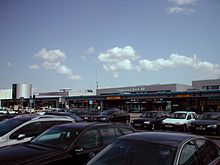
Lübeck is connected to three Main Motorways (Autobahnen). The A1 Throughway is heading due north to the Island of Fehmarn and Copenhagen (Denmark) and south to Hamburg, Bremen and Cologne. The A20 Expressway heads east towards Wismar, Rostock and Szczecin (Poland) and west to Bad Segeberg and to the North Body of water. The A226 Throughway starts in fundamental Lübeck and is heading to the n-eastward and the Seaport-City of Travemünde.
Lübeck is served by multiple train stations. The main i is Lübeck Hauptbahnhof, with about 31.000 passengers per mean solar day, is the busiest station in Schleswig-Holstein. The station is by and large served by regional rail services to Hamburg, Lüneburg, Kiel, the Isle of Fehmarn and Szczecin (Poland). In that location are some long-altitude trains to Munich, Frankfurt-am-Chief and Cologne. During the summer holidays, there are many actress rail services. Until the finish of 2019, Lübeck was a terminate on the "Vogelfluglinie" train line from Hamburg to Copenhagen (Kingdom of denmark).
Public transport by autobus is organized by the Lübeck City-Traffic-Company (Lübecker Stadtverkehr). There are 40 buslines serving the city and the surface area around Lübeck, in improver to regional motorbus services.
The commune of Travemünde is on the Baltic Sea and has the metropolis's main port. The Scandinavienkai (the quay of Scandinavia) is the difference bespeak for ferry routes to Malmö and Trelleborg (Sweden); Liepāja (Republic of latvia); Helsinki (Republic of finland) and Petrograd (Russia). It is the second-biggest German port on the Baltic Sea.
Lübeck Drome is located in the south of Lübeck in the town of Blankensee. It provides regional flights to Munich and Stuttgart and some charter flights to Italia and Croatia.
Notable people [edit]
Religion [edit]

- Laurentius Surius (1522–1578), Carthusian monk[18] and hagiographer
- August Hermann Francke (1663–1727), pedagogue,[19] theologian, founded the Francke Foundations
- Johann Lorenz von Mosheim (1693–1755), Lutheran[xx] church historian
- Ephraim Carlebach (1879–1936), rabbi and founder of the Higher Israelite School in Leipzig
- Joseph Carlebach (1883–1942), rabbi, victim of the Holocaust
- Felix Carlebach (1911–2008), rabbi
Politics [edit]

- Johann Wittenborg (1321–1363), Mayor of Lübeck, lost the Battle of Helsingborg
- Jürgen Wullenwever (c.1492–1537), burgomaster of Lübeck from 1533 to 1535
- George Wulweber, 16th-century Protestant who was tortured on the rack
- Friedrich Krüger (1819–1896), diplomat for the Hanseatic cities of Lübeck, Hamburg and Bremen
- John Rugee (1827–1894), political leader in Wisconsin, USA
- Gustav Radbruch (1878–1949), legal scholar and politician
- Hermann Lüdemann (1880–1959), CDU politician
- Otto-Heinrich Drechsler (1895–1945), Mayor of Lübeck 1933 to 1937, set upward the Riga ghetto
- Haim Cohn (1911–2002), Israeli jurist and political leader
- Willy Brandt (1913–1992), SPD politician,[21] High german chancellor
- Björn Engholm (born 1939), SPD politician
- Robert Habeck (born 1969), author and politician of the Alliance 90/The Greens
- Birgitt Ory (born 1964), diplomat
- Beatrix von Storch (born 1971), AfD politico, onetime MEP
Art [edit]

JF Overbeck, self portrait with family unit 1820
- Benjamin Block (1631–1690), German-Hungarian Baroque[22] painter
- Godfrey Kneller (1646–1723), court painter[23] of several British monarchs
- Catharina Elisabeth Heinecken (1683–1757), artist and alchemist
- Carl Heinrich von Heineken (1707–1791), art historian
- Friedrich Overbeck (1789–1869), painter[24] and caput of the Nazarenes
- Johann Wilhelm Cordes (1824–1869), landscape painter
- Gotthardt Kuehl (1850–1915), painter
- Maria Slavona (1865–1931), impressionist painter, sister of Cornelia Schorer
- Erich Ponto (1884–1957), actor
- Walter D. Asmus (built-in 1941), theatre director
- Justus von Dohnányi (born 1960), actor
- Jonas Nay (born 1990), actor

Music [edit]
- Franz Tunder (1614–1667), organist and composer
- Thomas Baltzar (c. 1631–1663), violinist[25] and composer
- Dieterich Buxtehude (c.1637–1707), composer and organist
- Andreas Kneller (1649–1724), composer and organist
- Friedrich Ludwig Æmilius Kunzen (1761–1817), composer
- Anja Thauer (1945–1973), cellist
Science [edit]

Robert Christian Ave-Lallemant in 1851
- Joachim Jungius (1587–1657), mathematician, physicist, and philosopher
- Heinrich Meibom (1638–1700), medical skilful, discovered the Meibomian gland
- Hermann von Fehling (1811–1885), chemist[26]
- Robert Christian Avé-Lallemant (1812–1884), doc and inquiry traveler
- Ernst Curtius (1814–1896), classical archaeologist[27] and historian
- Georg Curtius (1820–1885), philologist[28]
- Friedrich Matthias Claudius (1822–1869), anatomist
- James Behrens (1824–1898), entomologist[29]
- Friedrich Matz (1843–1874), archaeologist
- Friedrich Wilhelm Gustav Bruhn (1853–1927), invented the taximeter
- Cornelia Schorer (1863–1939), one of Germany's first female physicians
- Heinrich Lüders (1869–1943), orientalist and indologist
- Justus Mühlenpfordt (1911–2000), nuclear physicist
Writing [edit]

Heinrich (left) and Thomas Mann in 1902
- Erasmus Finx (1627–1694), polyhistorian, writer and church writer
- Christian Adolph Overbeck (1755–1821), mayor and poet
- Johann Bernhard Vermehren (1777–1803), romanticist and lecturer
- Emanuel Geibel (1815–1884), poet[30]
- Gustav Falke (1853–1916), writer
- Heinrich Isle of mann (1871–1950), novelist
- Thomas Mann (1875–1955), novelist, Nobel Prize for Literature in 1929
- Friedrich Ranke (1882–1950), a German medievalist, philologist, folklorist and writer
- Jörg Wontorra (born 1948), sport journalist
Sport [edit]
- Sandra Völker (born 1974), swimmer, won three medals at the 1996 Summer Olympics
- Marie-Louise Dräger (born 1981), five-time world champion lightweight sculler
- Tobias Kamke (built-in 1986), professional tennis player
- Maximilian Munski (built-in 1988), rower, silvery medallist at the 2016 Summer Olympics
Other [edit]

- Adam Brand (c. 1692–1746), merchant and researcher
- Christian Friedrich Heinecken (1721–1725), "the infant scholar of Lübeck", a child prodigy[31]
- Kurd von Schlözer (1822–1894), diplomat and historian
- Hermann von der Hude (1830–1908), architect
- Hermann Blohm (1848–1930), shipbuilder and visitor founder
- Hermann Pister (1885–1948), Nazi SS commandant of Buchenwald Concentration Army camp
- Walter Ewers (1892–1918), flying ace of WWI
- Hans Blumenberg (1920–1996), philosopher
- Jörg Ziercke (born 1947), principal commissioner of the Federal Criminal Police Function 2004–2014
Run across also [edit]
- Cap Arcona
- Lübeck Airdrome
- Lübeck Hauptbahnhof
- Lübeck Nordic Pic Days
- Lübeck law
- Lübecker Nachrichten is Lübeck'south just newspaper
- Oberschule zum Dom
- Ports of the Baltic Ocean
- Schleswig-Holstein Musik Festival
- VfB Lübeck, football and sports club
- Bombing of Lübeck in Earth War II
References [edit]
- ^ "Statistikamt Nord – Bevölkerung der Gemeinden in Schleswig-Holstein 4. Quartal 2020 (XLS-file)". Statistisches Amt für Hamburg und Schleswig-Holstein (in German language).
- ^ 1906–1937 and since 1956Vehicles registered between 1937 and 1956 were given prefixes valid for all of Schleswig-Holstein: "I P" (1937–1945), "S" (1945–1947), "SH" (1947 only), "BS" (1948–1956).
- ^ G.Lechner, Die Hanischen Pjundzollistern des Jahres 1368 (1935), pp.48, 198
- ^ G.Lechner, Die Hansischen Pjundzollisten des Jahres 1368 (1935), pp.66
- ^ Exports of butter, copper, osmund (a high-quality iron) and grunter atomic number 26. Units of fe were in lasts; 12 lasts were equivalent to one schiffspfund.
- ^ Pfundzollbucher of Lübeck
- ^ "Archived copy". Archived from the original on 30 September 2020. Retrieved 10 November 2015.
{{cite web}}: CS1 maint: archived copy as title (link) - ^ "Brandspuren im Gesicht, Ermittlungen zur Lübecker Asylheim-Katastrophe", Der Spiegel, 23/1996, three June 1996.
- ^ Hannoversche Allgemeine Zeitung, five March 2005
- ^ "Tot in Lübeck".
- ^ "G7-Gipfel in Lübeck: Dice Beschlüsse". Der Spiegel. xv April 2015.
- ^ Link
- ^ "Archived copy". Archived from the original on 12 Oct 2008. Retrieved 6 February 2012.
{{cite web}}: CS1 maint: archived copy as title (link) - ^ Sacirbey, Omar (6 June 2012). "A culinary treasure in marzipan in Lubeck, Germany". Boston World . Retrieved 18 May 2017.
- ^ Woolsey, Barbara (28 Nov 2015). "Deutschland'southward Sweet Spot Is This Marzipan Mill". Vice . Retrieved 24 Dec 2017.
- ^ Matthews, Patrick (21 January 2013). "German retailers phone call on European union to protect Rotspon". Decanter . Retrieved 18 May 2017.
- ^ a b "Partnerstädte und Freunde". luebeck.de (in German). Lübeck. Retrieved 19 Feb 2021.
- ^
 This commodity incorporates text from a publication now in the public domain:"Laurentius_Surius". Catholic Encyclopedia. Vol. 14. 1912.
This commodity incorporates text from a publication now in the public domain:"Laurentius_Surius". Catholic Encyclopedia. Vol. 14. 1912. - ^ . Encyclopædia Britannica. Vol. 11 (11th ed.). 1911.
- ^ . Encyclopædia Britannica. Vol. xviii (11th ed.). 1911.
- ^ Centre for Global Negotiations, Biography of Willy Brandt retrieved 21 March 2018
- ^ Benjamin von Block, RKD, NL retrieved 23 March 2018
- ^ . Encyclopædia Britannica. Vol. fifteen (11th ed.). 1911.
- ^ . Encyclopædia Britannica. Vol. 20 (11th ed.). 1911.
- ^ . Dictionary of National Biography. Vol. 03. 1885.
- ^ . Encyclopædia Britannica. Vol. x (11th ed.). 1911.
- ^ . Encyclopædia Britannica. Vol. 07 (11th ed.). 1911.
- ^ . Encyclopædia Britannica. Vol. 07 (11th ed.). 1911.
- ^ . Appletons' Cyclopædia of American Biography – via Wikisource.
- ^ . Encyclopædia Britannica. Vol. xi (11th ed.). 1911.
- ^ . Encyclopædia Britannica. Vol. thirteen (11th ed.). 1911.
Bibliography [edit]
- Zimmern, Helen (30 November 2005). Hansa Towns. Adamant Media Corporation. ISBN1402184832.
- Colvin, Ian Duncan (9 July 2012). The Germans in England 1066-1598. Forgotten Books. ASIN B008QQ2ZGC.
- Nicolle, David (xx April 2014). Forces of the Hanseatic League. Osprey Publishing. ISBN978-1782007791.
External links [edit]
- Jewish Encyclopedia: "Lübeck" past Gotthard Deutsch (1906).
- Hanseatic City of Lübeck: UNESCO Official Website
- Official website
- Official tourism site
- Panoramas of Lübeck
- Lovebridge Lübeck
- Rines, George Edwin, ed. (1920). . Encyclopedia Americana.
childresspeetuldience72.blogspot.com
Source: https://en.wikipedia.org/wiki/L%C3%BCbeck
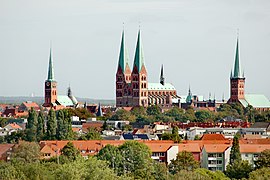




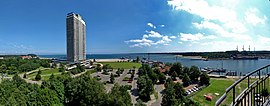





0 Response to "what was germanys port of entry to the us"
Post a Comment